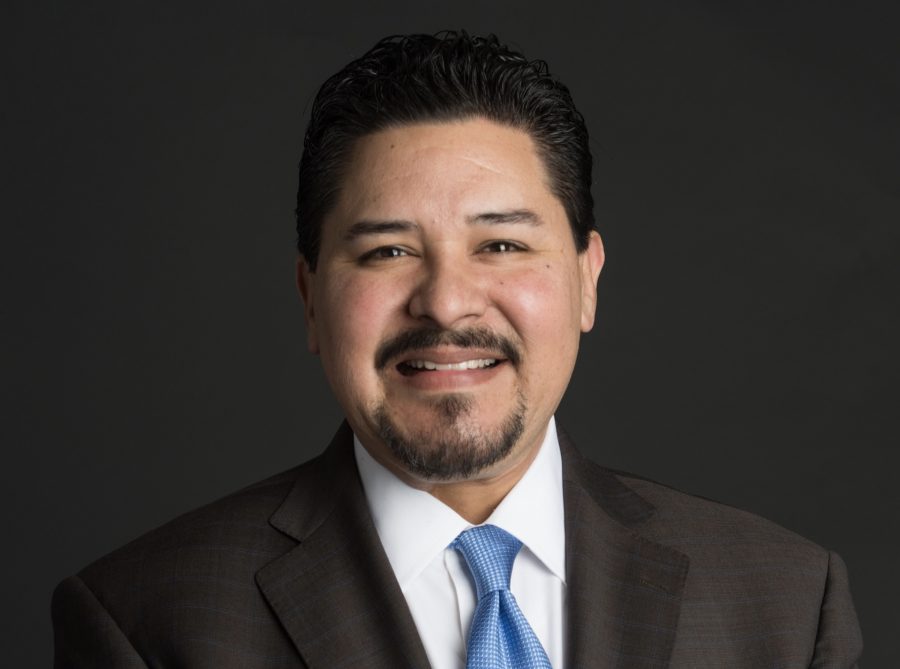The son of a sheet metal worker and a hairdresser, Richard A. Carranza is now Chancellor of the New York Department of Education. On Monday morning, Carranza spoke to NYU students and faculty about the state of NYC education as part of Steinhardt’s Leadership Lens series.
Carranza was appointed roughly six months ago by New York City Mayor Bill de Blasio and has been visiting schools and holding town halls across New York City since then. Carranza’s distinguished career has spanned across the educational spectrum. He began as a high school teacher and later worked his way up the ladder to superintendent of multiple school districts in Arizona, California and Texas.
Now, Carranza’s position makes him responsible for the education of 1.1 million students in 1,800 schools across New York City. His visit to Steinhardt was particularly important to the many Education Studies students in the audience. Carranza’s outlook on working is one that emphasizes firsthand interactions with students.
“I can learn so much more from being in the room with students and teachers. So much more than I can from being in a briefing”, Carranza told Steinhardt students.
Carranza attributes much of his career to the fact that he was brought up in the public school system, making him a stark defender of public schools and even calling them the cornerstone of our democracy.
Steinhardt senior Luz Cepeda felt Carranza’s narrative and relatability are at the heart of his ethos and resonated with students in the audience.
“I wasn’t expecting to connect with him on a deeper level,” Cepeda said. “I am of color and I am Latina so that was really interesting to me to see someone understand where I come from.”
When asked what educators should be doing to make the learning environment even stronger, Carranza stressed the importance of prioritizing the experience of the student.
“We need to be as contemporary as our students are,” Carranza told Steinhardt students and faculty. “The curriculum has to be as contemporary as our students are. Some of the stuff we teach is just boring and the way we teach it is boring”.
On the subject of technology in the classroom, Carranza explained that the best practice should be to embrace its role in today’s world and use it in a way to provoke curiosity and learning.
“Technology is ubiquitous. What if we switched the paradigm and asked: How do you use technology? Why is it Important?” Carranza said. “We should have curiosity in the classroom. Teachers cannot just be the disseminators of information, they have to be the facilitators of learning.”
When asked what we are not getting right about teacher training, Carranza noted that, especially in New York City, it is important for teachers to be adept at educating students in an urban environment, taking into account the degrees to which students in the inner city have different educational needs than students in a suburban environment.
Carranza cited things like student poverty, home resources and levels of parent education as elements that create harsh differences between students who come from urban backgrounds and students who live in the suburbs.
“Students who grow up in the city carry with them a whole array of different experiences that students in the suburbs do not,” Carranza said. “It is important for teachers to be able to work with students of all backgrounds, so the students can feel safe in school.”
Cepeda expressed appreciation for this comment.
“His point about urban education was very important because a lot of the teachers have a disconnect between the students that they’re teaching and the teacher’s own life experiences,” Cepeda said.
Sofia Flores, also a Steinhardt senior, agreed with Cepeda.
“I liked his brutally honest opinions about the education system,” Flores said. “He says, ‘I acknowledge this, and this is what I am doing today’ and I think that is one of the most important things that I learned from today. I see him on television and in the news but we don’t see the backside of it and this definitely helped us see what he does in reality.”
Carranza emphasized that one of the most important aspects of his position is that he needs to be actively engaging with teachers, students and policymakers on the ground level to make progress.
“What does great teaching and learning look like?” Carranza said. “Listen. Don’t talk and watch.”
Email Deets Sharma at [email protected]m.

























































































































































